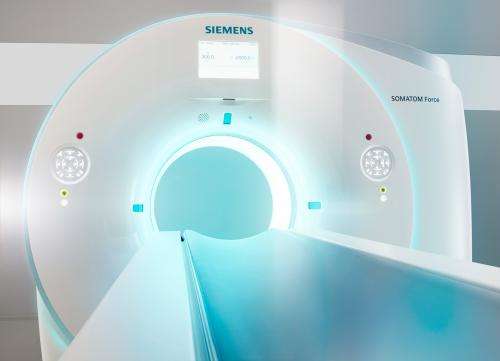Conservative, high-precision computed tomography

A new CT scanner from Siemens reduces the radiation dosage for patients by as much as a half, depending on the examination. The machine operates with unprecedented speed and can record image sequences with high temporal resolution. The signal-to-noise ratio of the CT Somatom Force is so good that significantly less contrast agent must be administered to patients. Since these agents contain iodine and put a strain on the kidneys, they are problematic especially for older persons or those with pre-existing conditions. Siemens recently presented the Somatom Force to the public at the University Medical Center Mannheim.
The ring-shaped gantry with two detectors and two X-ray tubes needs only a fourth of a second for one complete revolution around the body. That means the CT machine can scan a length of up to 73 centimeters in one second. The entire rib cage can thus be scanned quickly; patients no longer need to hold their breath in order to get a sharp image. Sharp images of the heart are possible even at pulse rates of 90, so that patients do not have to be given medication to lower the heart rate. This is due in part to the large, highly sensitive Stellar detectors developed by Siemens, which can image larger parts of the body with only one scan.
The Somatom Force can record a new image every 66 microseconds. The short imaging time minimizes radiation exposure and makes it possible to create image sequences with very high temporal resolutions. The "functional 4D imaging" performed by the machine captures not just organ anatomy but also organ function. For example, this might include the flow of blood in a vessel over time, or the spread of a contrast agent over time in the organ being examined. In the past, examinations of this kind have required high doses of radiation, but these can now be reduced by up to 50 percent with the Somatom Force.
The Vectron X-ray tubes of the new CT scanner allow particularly low tube voltages. This improves the signal-to-noise ratio, and the organs being examined can also be clearly identified in the CT images with smaller amounts of contrast agent. Initial examinations in Mannheim have shown that the quantity of contrast agent can be reduced to approximately a third. This is especially beneficial to patients with kidney diseases, because many contrast agents put an added strain on the kidneys.
Its extremely low radiation dosage makes the Somatom Force particularly appropriate for medical check-ups, in which radiation exposure must be kept as low as possible because healthy persons are being X-rayed merely for preventive purposes.


















